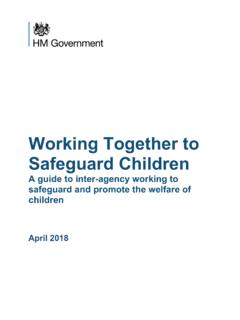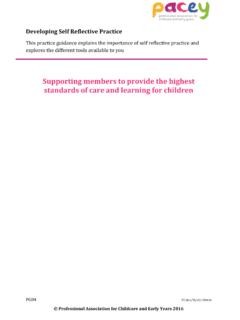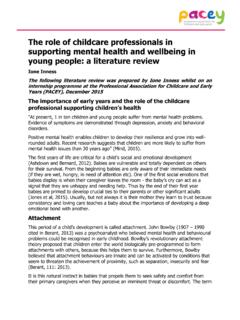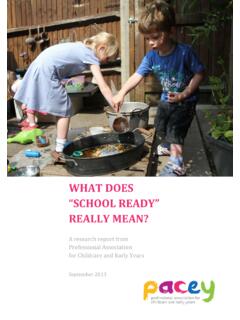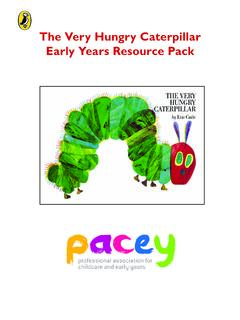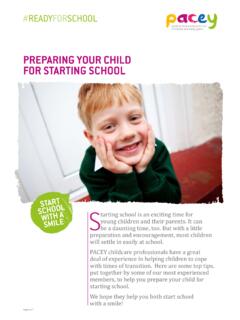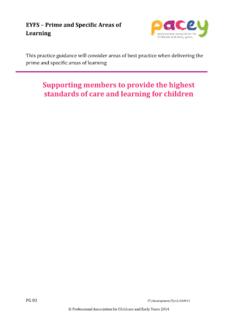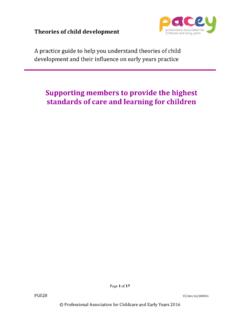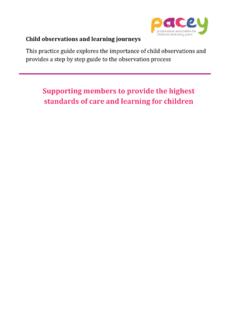Transcription of Coronavirus (COVID-19) risk assessment
1 Coronavirus (COVID-19) Risk assessment Produced for childcare settings in England and Wales by Updated November 2021 Coronavirus (COVID-19) Risk assessment This risk assessment template will help you identify potential risks associated with Coronavirus (COVID-19). Our main aim is to make childcare settings as safe as possible for children, staff and families, so we ve come up with some areas for you to look at to help you assess risk in your settings, based on government guidance. This guidance may change or differ locally. Make sure you are up to date with current advice.
2 This example is designed to help early years and childcare providers, both group and home-based settings, carry out a risk assessment . You should write your own risk assessment , taking into account the needs of your particular childcare setting and the families you work with. There is a blank template available. Review your risk assessment and your risk assessment policy (in England) or policy guidance (in Wales) regularly. Take a whole setting approach and consider the risks and the measures you plan to put in place from a child s point of view, as well as from staff and parents points of view.
3 Regularly reassess the risks in light of updates to government guidance and any changes at your setting. For example, reassess if you, a family member (for home-based settings), a staff member, a child in your care, or someone in one of their families with becomes unwell with Coronavirus symptoms. Or other changes such as a child leaving or joining your setting or moving to a different developmental stage, for example crawling or walking. Make a note of what s working well and what people (adults or children) are struggling with depending on government restrictions and/or local advice given at the time.
4 Take some time to assess what this means for your particular setting. Be confident and assertive when introducing new routines and any changes needed to keep you, your family and the children and families you work with safe, for example wearing face coverings and social distancing when appropriate. The risk for all of the hazards mentioned is becoming infected with Coronavirus . Everyone that comes to your setting is at risk although some people are more at risk than others. Check the NHS guidance if you are concerned about any of the families that use your setting.. Useful links PACEY Childcare Toolkit For Early Years Settings English government guidance Actions for early years and childcare providers during the Coronavirus (Covid-19) outbreak Safe Working in Education, Childcare and Children s Social Care Settings, Including the Use of Personal Protective Equipment (PPE) Welsh government guidance Welsh government guidance is listed on this web page.
5 Health Protection Team Infection Prevention and Control Guidance (2019) for Childcare Settings (0-5 years) in Wales Remember to check frequently for any updates to this government guidance. Also check any guidance that comes from your local authority as this may differ from national guidance. This risk assessment covers the main control measures in relation to practice, however there may be other areas you want to consider based on your individual setting and practice and in line with government published guidance. 1. Ensuring good hygiene for everyone 2. Maintain appropriate cleaning regimes 3.
6 Good ventilation in occupied areas 4. Following public health advice on Covid testing, self-isolation and managing positive Coronavirus cases Change the date to keep a record of when you update your own risk assessment . 1. Ensure good hygiene for everyone, includes hand washing and respiratory hygiene Date Identify Hazards What can be done to remove or lessen the risk? Action To Take (mark when done) Recheck: when and how Infection spreads easily from unclean hands. Clean my hands more often than usual, particularly before starting work, touching my face, blowing my nose, sneezing or coughing, and before eating or handling food.
7 Encourage staff and children to wash their hands more often too. To clean my hands I, any staff members and the children will wash our hands thoroughly for 20 seconds with soap and running water and dry them thoroughly, or use alcohol-based hand sanitizer, ensuring that all Check stocks of soap and handwash as well as paper towels for drying Check stocks of hand sanitiser Practice handwashing routines with the children Implement any new handwashing routines, for example, on arrival at the setting Complete and ensure all staff have completed relevant training for example, CEY smart handwashing course.
8 I/we must ensure that children clean their hands regularly, including: Regularly throughout the day parts of the hands are covered. - when they arrive at the setting - when they return from breaks - when they change rooms - Before and after eating - Before and after messy play Coronavirus can be transmitted by being in close contact with those sneezing or coughing. I will ensure the children follow these instructions: - Where possible, avoid touching your mouth, eyes and nose. - Cover your mouth and nose with disposable tissues when you cough or sneeze.
9 If one is not available, sneeze into the crook of your elbow, not into your hand. Dispose of tissues into a disposable rubbish bag and immediately wash your hands with soap and Use the resources on e-Bug to help children understand about Coronavirus . If someone is sneezing or coughing, check to see if they have other possible Coronavirus symptoms. Ensure a good supply of disposable tissues. Daily water or use a hand sanitiser. Use of face coverings- Not compulsory in childcare settings but use can be considered in line with risk assessment . Date Identify Hazards What can be done to remove or lessen the risk?
10 Action To Take (mark when done) Recheck: when and how Coronavirus can be transmitted by being in close contact with people, for example when in communal areas Wearing a secure fitting face covering which safely covers the nose and mouth can help reduce the spread of Coronavirus . Transparent face coverings can be used to assist communication where people rely on visual cues such as lip reading. Consider whether face coverings should be used in situations where social distancing between adults is not possible Have a contingency supply of face coverings for staff or visitors who do not have one Apply safe wearing guidance.

